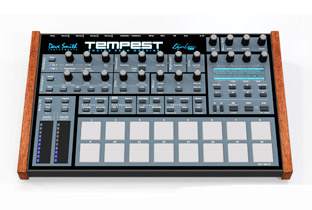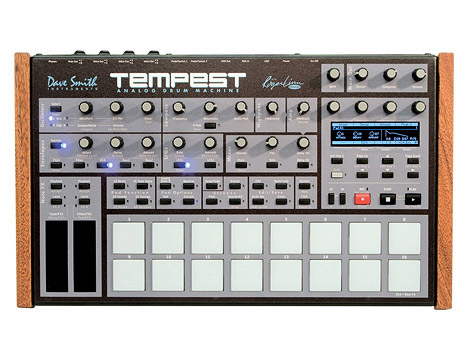Published
Tue, Feb 15, 2011, 14:00
- Our weekly music tech column looks ahead to the release of Dave Smith and Roger Linn's new drum machine.

Sounding Off is a regular series in which Jono Buchanan offers his thoughts, advice and analysis on the world of music technology.
In my first Sounding Off column a few weeks back, I gave you an overview of some of NAMM's highlights. As the dust settles after the show, I thought this week might be a good time to feature a more in-depth preview of one of NAMM's more tantalizing prospects; the collaboration between Dave Smith (of DSI fame) and Roger Linn, who have combined their skills to produce the Tempest Drum Machine, due for release in the summer.
There are a number of reasons why I have high hopes for Tempest, which starts with the CVs of those responsible for creating it. Roger Linn can claim to have been the inventor of the digital drum machine as we know it today. The LM-1 Drum Computer, released in 1979, was the first commercial drum machine to feature samples at its core—remember, this was well before sampling became standard studio practice. The LM-1 quickly gave way to other variants of the drum machine concept in the form of first the LinnDrum and then the Linn 9000, which became a staple sound of electronic records made through the 1980s, perhaps explaining why the Linn sound is back in vogue.
As sampling took off and producers started building their own libraries of sounds and beats, dedicated drum machines struggled and Linn Electronics folded in 1986. This was by no means the end of Linn's involvement in seminal beat box production, however, as he was subsequently employed by Akai to work on designs and concepts for what became the MPC range of products.
Dave Smith, Tempest's other architect, has a similarly impressive resumé. Having built the first polyphonic synthesizer in the form of the Sequential Circuits Prophet V, he was then a major player in the development of MIDI, the language on which studios are still so dependent today, fully 30 years after its initial inception (how many other technologies in our industry have lasted as long?!). After Sequential Circuits, Smith was also recruited for work in the Far East, aiding both Yamaha and then Korg with products including the Wavestation. Smith then moved into development of soft synths with huge commercial success before coming full circle, establishing Dave Smith Instruments to start building hardware synths once more, such as the glorious Prophet 08 and its assorted off-shoots, including the Tetra and Mopho range.
 A collaborative project from these two friends has long been expected with a 'Vaporware' product entitled BoomChik first previewed, in photo form only, as far back as 2007. BoomChik never materialized, which was also true of Linn Drum II, the second product to be heard discussed in darkened corners of the excited technology industry. So, Tempest represents an exciting prospect on paper but with beat boxes aplenty currently popular in both hard and software forms, what might Tempest offer which goes beyond the competition?
For starters, combining Linn's drum machine know-how and Smith's analog synth brain is mouth-watering; as plenty of Tempest's sound producing capabilities are derived from analogue sound sources (oscillators, in other words), you're not saddled with the limitations of just stacking a drum machine full of samples, though there are plenty of these on board too, including sampled waveforms from the Prophet VS. There are two analogue oscillators, two digital ones and a sub-oscillator per voice before the sound is channeled to the now-famous DSI filter section combining both low and high pass options. There are analogue stereo output compressor and distortion modules built in too with individual voice outputs and USB connectors on the back panel.
The digital heart of the machine extends to a display screen which helps you configure sounds. The front panel is stacked with 90 real-time panel controls, while the lit, animated pads can be used to trigger sounds, patterns or sequences, configured to play back 16 tuned versions of the same sound, used as mutes for parts within a sequence and so on. There are also two slide controls which pick up on position and pressure to the left of the pads which can be targeted at parameters you like, while a roll button provides stutter editing, in real time.
Tempest provides a range of tools drum machine aficionados now expect, including variable swing groove, multiple sound sources available simultaneously and easy switching between sounds and kits but what's unique about this machine is its heritage. The richness of sound and, if you so choose, a true analogue signal path from start to finish promises unrivaled performance. Linn has clearly used Tempest as a means to further tweak his wide range of experiences in drum machine design amassed over 30 years. I, for one, can't wait.
A collaborative project from these two friends has long been expected with a 'Vaporware' product entitled BoomChik first previewed, in photo form only, as far back as 2007. BoomChik never materialized, which was also true of Linn Drum II, the second product to be heard discussed in darkened corners of the excited technology industry. So, Tempest represents an exciting prospect on paper but with beat boxes aplenty currently popular in both hard and software forms, what might Tempest offer which goes beyond the competition?
For starters, combining Linn's drum machine know-how and Smith's analog synth brain is mouth-watering; as plenty of Tempest's sound producing capabilities are derived from analogue sound sources (oscillators, in other words), you're not saddled with the limitations of just stacking a drum machine full of samples, though there are plenty of these on board too, including sampled waveforms from the Prophet VS. There are two analogue oscillators, two digital ones and a sub-oscillator per voice before the sound is channeled to the now-famous DSI filter section combining both low and high pass options. There are analogue stereo output compressor and distortion modules built in too with individual voice outputs and USB connectors on the back panel.
The digital heart of the machine extends to a display screen which helps you configure sounds. The front panel is stacked with 90 real-time panel controls, while the lit, animated pads can be used to trigger sounds, patterns or sequences, configured to play back 16 tuned versions of the same sound, used as mutes for parts within a sequence and so on. There are also two slide controls which pick up on position and pressure to the left of the pads which can be targeted at parameters you like, while a roll button provides stutter editing, in real time.
Tempest provides a range of tools drum machine aficionados now expect, including variable swing groove, multiple sound sources available simultaneously and easy switching between sounds and kits but what's unique about this machine is its heritage. The richness of sound and, if you so choose, a true analogue signal path from start to finish promises unrivaled performance. Linn has clearly used Tempest as a means to further tweak his wide range of experiences in drum machine design amassed over 30 years. I, for one, can't wait.
 A collaborative project from these two friends has long been expected with a 'Vaporware' product entitled BoomChik first previewed, in photo form only, as far back as 2007. BoomChik never materialized, which was also true of Linn Drum II, the second product to be heard discussed in darkened corners of the excited technology industry. So, Tempest represents an exciting prospect on paper but with beat boxes aplenty currently popular in both hard and software forms, what might Tempest offer which goes beyond the competition?
For starters, combining Linn's drum machine know-how and Smith's analog synth brain is mouth-watering; as plenty of Tempest's sound producing capabilities are derived from analogue sound sources (oscillators, in other words), you're not saddled with the limitations of just stacking a drum machine full of samples, though there are plenty of these on board too, including sampled waveforms from the Prophet VS. There are two analogue oscillators, two digital ones and a sub-oscillator per voice before the sound is channeled to the now-famous DSI filter section combining both low and high pass options. There are analogue stereo output compressor and distortion modules built in too with individual voice outputs and USB connectors on the back panel.
The digital heart of the machine extends to a display screen which helps you configure sounds. The front panel is stacked with 90 real-time panel controls, while the lit, animated pads can be used to trigger sounds, patterns or sequences, configured to play back 16 tuned versions of the same sound, used as mutes for parts within a sequence and so on. There are also two slide controls which pick up on position and pressure to the left of the pads which can be targeted at parameters you like, while a roll button provides stutter editing, in real time.
Tempest provides a range of tools drum machine aficionados now expect, including variable swing groove, multiple sound sources available simultaneously and easy switching between sounds and kits but what's unique about this machine is its heritage. The richness of sound and, if you so choose, a true analogue signal path from start to finish promises unrivaled performance. Linn has clearly used Tempest as a means to further tweak his wide range of experiences in drum machine design amassed over 30 years. I, for one, can't wait.
A collaborative project from these two friends has long been expected with a 'Vaporware' product entitled BoomChik first previewed, in photo form only, as far back as 2007. BoomChik never materialized, which was also true of Linn Drum II, the second product to be heard discussed in darkened corners of the excited technology industry. So, Tempest represents an exciting prospect on paper but with beat boxes aplenty currently popular in both hard and software forms, what might Tempest offer which goes beyond the competition?
For starters, combining Linn's drum machine know-how and Smith's analog synth brain is mouth-watering; as plenty of Tempest's sound producing capabilities are derived from analogue sound sources (oscillators, in other words), you're not saddled with the limitations of just stacking a drum machine full of samples, though there are plenty of these on board too, including sampled waveforms from the Prophet VS. There are two analogue oscillators, two digital ones and a sub-oscillator per voice before the sound is channeled to the now-famous DSI filter section combining both low and high pass options. There are analogue stereo output compressor and distortion modules built in too with individual voice outputs and USB connectors on the back panel.
The digital heart of the machine extends to a display screen which helps you configure sounds. The front panel is stacked with 90 real-time panel controls, while the lit, animated pads can be used to trigger sounds, patterns or sequences, configured to play back 16 tuned versions of the same sound, used as mutes for parts within a sequence and so on. There are also two slide controls which pick up on position and pressure to the left of the pads which can be targeted at parameters you like, while a roll button provides stutter editing, in real time.
Tempest provides a range of tools drum machine aficionados now expect, including variable swing groove, multiple sound sources available simultaneously and easy switching between sounds and kits but what's unique about this machine is its heritage. The richness of sound and, if you so choose, a true analogue signal path from start to finish promises unrivaled performance. Linn has clearly used Tempest as a means to further tweak his wide range of experiences in drum machine design amassed over 30 years. I, for one, can't wait.